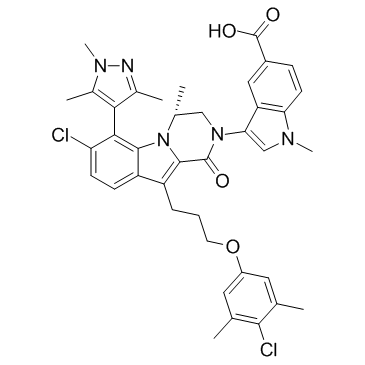| In Vivo |
VU661013, a novel, potent, selective MCL-1 inhibitor that de-stabilizes BIM/MCL-1 association, leads to apoptosis in AML, and is active in Venetoclax-resistant cells and patient derived xenografts. After establishing disseminated leukemia, NSGS mice are dosed intraperitoneally with 10, 25 or 75 mg/kg of VU661013 daily for 21 days. Weekly chimerism analyses are conducted and the percentage of MV-4-11 cells are quantified in murine peripheral blood using anti-human CD45 (hCD45) and anti-hCD33 monoclonal antibodies. Twenty-eight days post-transplant, vehicle-treated mice have developed large leukemia burdens and thus, mice are sacrificed, and their organs are harvested for analysis. Vehicle mice treated died of xenografted AML, but have no evidence of VU661013-related toxicity in non target organs. VU661013 treatment of disseminated human AML results in a dose-dependent decrease in tumor burden, nearly eliminating the hCD45+ MV-4-11 cells at the 75 mg/kg dose in the blood (mean, 13.0±2.2% in vehicle vs 7.4±7.2% in 25mg/kg vs 0.17±0.12% in 75 mg/kg treated mice), bone marrow (mean, 40.7±13.9% in vehicle vs 33.46±4.0 % in 25 mg/kg vs 0.384±0.345 in 75 mg/kg treated mice), and spleen (mean, 46.22±13.3% in vehicle vs 13.31±10.0% in 25 mg/kg vs 1.588±1.51% in 75 mg/kg treated mice). Treatment with VU661013 reduces disease-associated splenomegaly (mean, vehicle vs. 75mg/kg, 0.17±0.02 vs 0.09±0.01g), and amendeding spleen to body weight ratio (vehicle vs 75mg/kg, 0.99 vs 0.50). In a second MV-4-11 xenograft study, mice are followed until death, and survival is evaluated by Kaplan-Meier analysis. In this study, NSGS mice are treated daily (starting 7 days after transplant) with vehicle only, 15 mg/kg or 75 mg/kg of VU661013. Analysis reveals an increase in survival in mice treated with the 75mg/kg dose (vehicle treated mice=31 days, vs 15 mg/kg=32 days, vs 75 mg/kg treated mice=43 Days)[1].
|
| Animal Admin |
Mice[1] Upon establishing microchimerism, mice are treated with either Venetoclax by daily gavage, VU661013 (10, 25 or 75 mg/kg) by daily i.p injection, or vehicle. VU661013 is dissolved in DMSO and diluted in ethanol, Polyethylene Glycol (PEG), and saline. Venetoclax is dissolved in PEG and ethanol, and diluted with Phosal 50 PG. Peripheral blood is assessed weekly for human chimerism. Spleen/body ratio is calculated as organ weight (gram) per gram of body weight[1].
|
